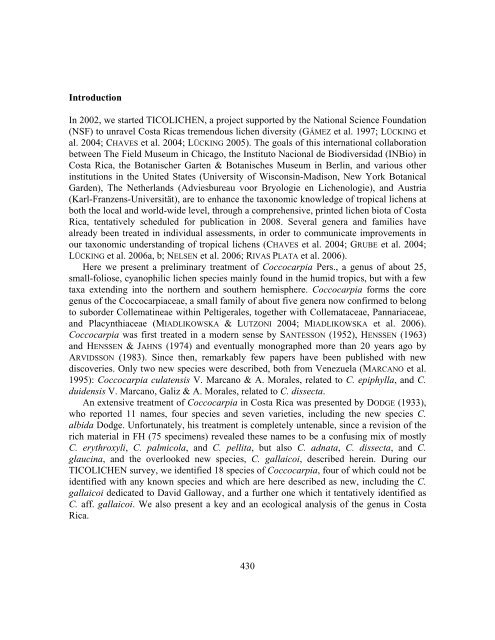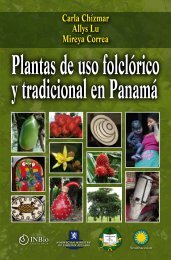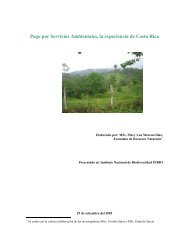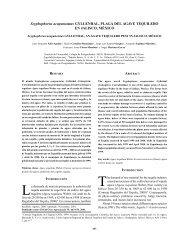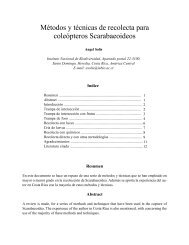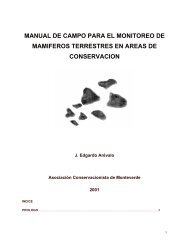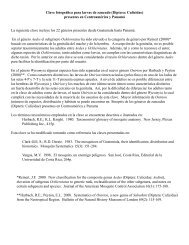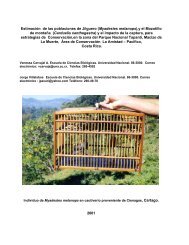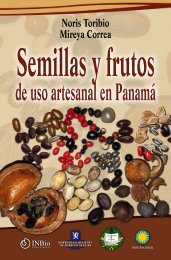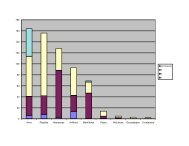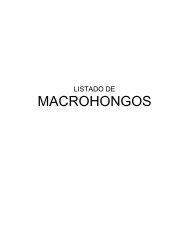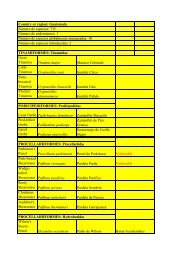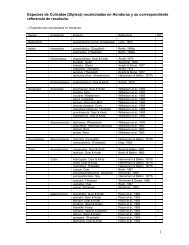the genus Coccocarpia (Peltigerales: Coccocarpiaceae) - Instituto ...
the genus Coccocarpia (Peltigerales: Coccocarpiaceae) - Instituto ...
the genus Coccocarpia (Peltigerales: Coccocarpiaceae) - Instituto ...
You also want an ePaper? Increase the reach of your titles
YUMPU automatically turns print PDFs into web optimized ePapers that Google loves.
Introduction<br />
In 2002, we started TICOLICHEN, a project supported by <strong>the</strong> National Science Foundation<br />
(NSF) to unravel Costa Ricas tremendous lichen diversity (GÁMEZ et al. 1997; LÜCKING et<br />
al. 2004; CHAVES et al. 2004; LÜCKING 2005). The goals of this international collaboration<br />
between The Field Museum in Chicago, <strong>the</strong> <strong>Instituto</strong> Nacional de Biodiversidad (INBio) in<br />
Costa Rica, <strong>the</strong> Botanischer Garten & Botanisches Museum in Berlin, and various o<strong>the</strong>r<br />
institutions in <strong>the</strong> United States (University of Wisconsin-Madison, New York Botanical<br />
Garden), The Ne<strong>the</strong>rlands (Adviesbureau voor Bryologie en Lichenologie), and Austria<br />
(Karl-Franzens-Universität), are to enhance <strong>the</strong> taxonomic knowledge of tropical lichens at<br />
both <strong>the</strong> local and world-wide level, through a comprehensive, printed lichen biota of Costa<br />
Rica, tentatively scheduled for publication in 2008. Several genera and families have<br />
already been treated in individual assessments, in order to communicate improvements in<br />
our taxonomic understanding of tropical lichens (CHAVES et al. 2004; GRUBE et al. 2004;<br />
LÜCKING et al. 2006a, b; NELSEN et al. 2006; RIVAS PLATA et al. 2006).<br />
Here we present a preliminary treatment of <strong>Coccocarpia</strong> Pers., a <strong>genus</strong> of about 25,<br />
small-foliose, cyanophilic lichen species mainly found in <strong>the</strong> humid tropics, but with a few<br />
taxa extending into <strong>the</strong> nor<strong>the</strong>rn and sou<strong>the</strong>rn hemisphere. <strong>Coccocarpia</strong> forms <strong>the</strong> core<br />
<strong>genus</strong> of <strong>the</strong> <strong>Coccocarpia</strong>ceae, a small family of about five genera now confirmed to belong<br />
to suborder Collematineae within <strong>Peltigerales</strong>, toge<strong>the</strong>r with Collemataceae, Pannariaceae,<br />
and Placynthiaceae (MIADLIKOWSKA & LUTZONI 2004; MIADLIKOWSKA et al. 2006).<br />
<strong>Coccocarpia</strong> was first treated in a modern sense by SANTESSON (1952), HENSSEN (1963)<br />
and HENSSEN & JAHNS (1974) and eventually monographed more than 20 years ago by<br />
ARVIDSSON (1983). Since <strong>the</strong>n, remarkably few papers have been published with new<br />
discoveries. Only two new species were described, both from Venezuela (MARCANO et al.<br />
1995): <strong>Coccocarpia</strong> culatensis V. Marcano & A. Morales, related to C. epiphylla, and C.<br />
duidensis V. Marcano, Galiz & A. Morales, related to C. dissecta.<br />
An extensive treatment of <strong>Coccocarpia</strong> in Costa Rica was presented by DODGE (1933),<br />
who reported 11 names, four species and seven varieties, including <strong>the</strong> new species C.<br />
albida Dodge. Unfortunately, his treatment is completely untenable, since a revision of <strong>the</strong><br />
rich material in FH (75 specimens) revealed <strong>the</strong>se names to be a confusing mix of mostly<br />
C. erythroxyli, C. palmicola, and C. pellita, but also C. adnata, C. dissecta, and C.<br />
glaucina, and <strong>the</strong> overlooked new species, C. gallaicoi, described herein. During our<br />
TICOLICHEN survey, we identified 18 species of <strong>Coccocarpia</strong>, four of which could not be<br />
identified with any known species and which are here described as new, including <strong>the</strong> C.<br />
gallaicoi dedicated to David Galloway, and a fur<strong>the</strong>r one which it tentatively identified as<br />
C. aff. gallaicoi. We also present a key and an ecological analysis of <strong>the</strong> <strong>genus</strong> in Costa<br />
Rica.<br />
430


